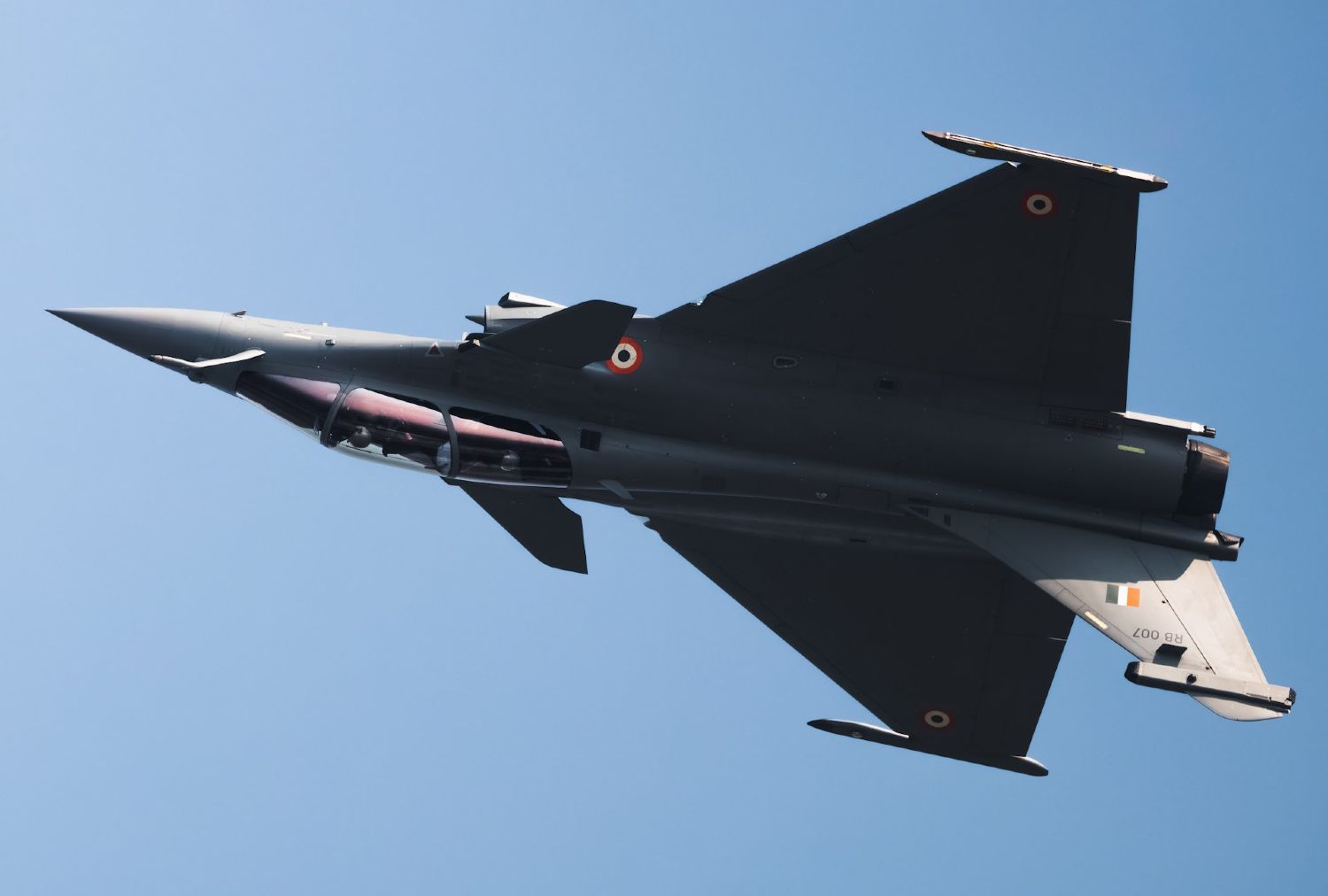Military analysts are still debating the results of the brief India-Pakistan clash in May. However, according to a new US Congress report, the real winner of the four-day war was neither India nor Pakistan; instead, it was China.
Beijing “opportunistically” turned the conflict into a live testing ground for its advanced weaponry and intelligence systems, and then aggressively marketed those results to undercut Western arms sales, the bipartisan US Congress report found.
“Beijing opportunistically leveraged the conflict to test and advertise the sophistication of its weapons, useful in the contexts of its ongoing border tensions with India and its expanding defense industry goals,” a new report from the US-China Economic and Security Review Commission found.
During the four-day war in May (May 7-10), Pakistan not only used Chinese warplanes like JF-17 and J-10C, beyond-visual-range (BVR) air-to-air missiles like PL-15, air defense systems like HQ-9 and HQ-16, and drones, but also used the Chinese reconnaissance satellites and the BeiDou Navigation Satellite System.
Notably, the event marked the combat debut of all these Chinese weapons systems.
The last time China fought an active war was against Vietnam in the late 1970s, and none of these weapons systems had debuted till then.
In fact, Beijing fought that war mostly with Soviet weapons, and the Chinese arms industry, as we know it today, had not even been born then. Since then, China has made remarkable progress in developing a high-tech, indigenous arms industry.
However, according to the SIPRI 2025 report, despite this striking progress, Beijing still controls only 5.9% of the total global arms exports, and only a handful of countries, most prominently Pakistan, buy Chinese weapons.
One of the biggest impediments to Chinese weapons sales was that they were not tested in combat, and Beijing tried to use the India-Pakistan clash to overcome this handicap.
“This clash was the first time China’s modern weapons systems, including the HQ-9 air defense system, PL-15 air-to-air missiles, and J-10 fighter aircraft, were used in active combat, serving as a real-world field experiment,” the report said.
However, the report cautioned that it would be a mistake to read the India-Pakistan clash only as China’s “proxy-war”.
“While characterization of this conflict as a “proxy war” may overstate China’s role as an instigator, Beijing opportunistically leveraged the conflict to test and advertise the
sophistication of its weapons,” the report added.
How Many Jets Were Shot Down During The India-Pakistan Clash?
One of the most pestering questions since the India-Pakistan clash in May has been how many jets were shot down during the aerial clash on the night of May 7.
This was the biggest aerial battle between the two countries since the 1971 war. According to various accounts, more than 125 fighter jets battled for air superiority between India and Pakistan during the night of May 7.
Pakistan claimed that it shot down five Indian fighter planes, including three Rafales. However, after some weeks, Islamabad started claiming that it shot down six Indian fighter jets, including four Rafales.
India accepted combat losses; however, it refused to give details as to how many or which aircraft were shot down.

US President Donald Trump has repeatedly claimed that eight fighter jets were shot down during that clash. However, the latest US Congress report says that three Indian fighter jets were shot down, and perhaps not all were Rafales.
“Pakistan’s use of Chinese weapons to down French Rafale fighter jets used by India also became a particular selling point for Chinese Embassy defense sales efforts despite the fact that only three jets flown by India’s military were reportedly downed and all may not have been Rafales.”
Notably, in July, French Air Force Chief Gen. Jérôme Bellanger also stated that he has seen evidence indicating just three Indian losses — a Rafale, a Russian-made Sukhoi, and a Mirage 2000.
Meanwhile, Dassault Aviation Chairman and CEO Éric Trappier stated that India had lost just one Rafale fighter jet. However, the incident was attributed to a high-altitude technical failure rather than an enemy shootdown.
The incident occurred “at an altitude of over 12,000 meters during an extended training mission, with no enemy involvement or hostile radar contact,” Trappier said.
How China Used Alleged Rafale Loss To Boost Its Aircraft Sales
The US Congress report says that China tried to leverage the clash to boost the sales of its fighter jets and other weapons systems.
“In the weeks after the conflict, Chinese embassies hailed the successes of its systems in the India-Pakistan clash, seeking to bolster weapons sales. Pakistan’s use of Chinese weapons to down French Rafale fighter jets used by India also became a particular selling point for Chinese Embassy defense sales efforts,” the report said.
However, the US Congress report concluded that apart from peddling Pakistani propaganda that as many as three Indian Rafale fighter jets were downed, the Chinese embassy also utilized fake AI-generated images of fighter jet debris, and footage from video games to bolster its sales pitch that Chinese jets shot down multiple Rafale fighter jets.
“According to French intelligence, China initiated a disinformation campaign to hinder sales of French Rafales in favor of its own J-35s, and it used fake social media accounts to propagate AI and video game images of supposed ‘debris’ from the planes China’s weaponry destroyed,” the report said.
According to a French intelligence report published in July, which the EurAsian Times reported in detail, more than 1,000 social media accounts were created to push the narrative of Chinese technological superiority.

It added that this disinformation campaign had at least partial success, as Chinese embassy staff were able to convince Indonesia to halt its Rafale fighter jet purchase program.
“Chinese Embassy officials convinced Indonesia to halt a purchase of Rafale jets already in process, furthering China’s inroads into other regional actors’ military procurements.”
However, the Chinese success was short-lived, as despite Beijing’s sustained propaganda, Indonesia not only stood with its earlier order of 42 Rafales but also doubled down on the French fighter jet by signing a follow-up Letter of Intent (LoI) for 24 additional Rafale fighters.
Trump ‘Slams’ $13B USS Gerald R Ford’s EMALS Tech; Orders Steam Revival As China’s Fujian Masters It
Still, the India-Pakistan clash did boost the image of Chinese fighter jets.
In September, Azerbaijan signed a US$4.6 billion defense deal with Pakistan to acquire 40 JF-17 Block III fighter jets. Indonesia later inked a pact to purchase 42 Chinese J-10C fighter jets.
The brief war has demonstrated to China the multifaceted advantages of fighting India through Pakistan.
On the one hand, by arming Pakistan, China can keep India, its strategic rival, off-balance. Secondly, by propping up Pakistan, Beijing can keep India tied to its Western border.
China can also use India-Pakistan clashes as a live testing ground for its advanced weaponry and intelligence systems, and then aggressively market those results to undercut Western arms sales.
The US Congress report also underlines the burgeoning China-Pakistan nexus.
“China expanded its military cooperation with Pakistan in 2025, compounding its own security tensions with India. In November and December 2024, China and Pakistan held the three-week Warrior-VIII counterterrorism drills, and in February 2025, China’s navy participated in Pakistan’s multinational AMAN drills, highlighting China’s and Pakistan’s growing defense cooperation.”
Furthermore, the report highlights the ever-rising China-Pakistan arms trade.
“As Pakistan’s largest defense supplier, China provided approximately 82 percent of the country’s arms imports from 2019 to 2023,” it said.
However, the Chinese strategy of leveraging India-Pakistan clashes as a testing ground for the combat performance of its weapons systems is a double-edged sword that can also backfire.
For instance, during the four-day clash, India targeted nine terror training camps and 11 Pakistani air bases across the length and width of the country, highlighting glaring gaps in Islamabad’s air defense systems, which are overwhelmingly of Chinese origin.
India claimed to have destroyed 9-10 Pakistani fighter jets, including F-16s and Chinese JF-17s, besides the C-130 military transport aircraft and a couple of AEW&C aircraft. You can read the full EurAsian Times story here.
There is no mention of how many aircraft Pakistan lost, but if Trump is to be believed, eight aircraft were shot down during the India-Pak May clash. If India lost 3, does that mean Pakistan lost five warplanes?
- Sumit Ahlawat has over a decade of experience in news media. He has worked with Press Trust of India, Times Now, Zee News, Economic Times, and Microsoft News. He holds a Master’s Degree in International Media and Modern History from the University of Sheffield, UK.
- VIEWS PERSONAL OF THE AUTHOR.
- He can be reached at ahlawat.sumit85 (at) gmail.com




